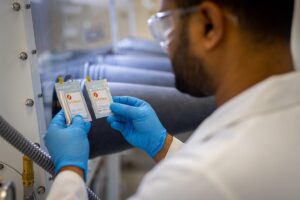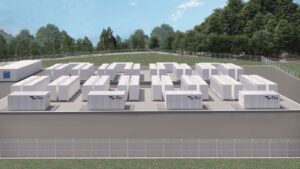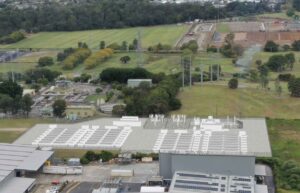The dramatic entry of US investment giant BlackRock into the Australian battery storage market this week introduces a deep-pocketed new player in the rapidly growing market. But having lots of money to throw at the opportunity is only half the story.
Akaysha Energy, the Melbourne-based storage developer bought by BlackRock, and staffed by former Tesla, Macquarie and Engie executives, is planning to push the limits of the battery market in other ways – both in long term storage and new frontiers in Australia’s grid.
As we reported on Tuesday, Akaysha has a portfolio of nine battery storage projects, three of which have been revealed – a 150MW/300MWh project at Ulinda Park, next to the Kogan Creek coal generator in Queensland, and the Orana and Palmerston battery projects in NSW and Tasmania respectively.
Ulinda Park is relatively plain vanilla as far as battery business plans go. BlackRock and Akaysha hope to reach financial close in the next six months for a “merchant” facility that will target short term storage opportunities and the now typical frequency control and ancillary services.
The other two batteries are more interesting, both for what they will do and how and where they plan to do it. Orana is targeting up to eight hours of battery storage, hitherto unheard of in Australia, while the Palmerston battery will be the first in Tasmania and is targeting the significant inertia shortfall in that island’s grid.
The size of the Orana battery, near Wellington in the central west of NSW is not settled. On the Akaysha website it is described as 200MW and 400MW, with 1600MWh or up to eight hours of storage.
And that could largely be because it will be built in the heart of the new Central West Orana renewable energy zone, the first of at least five REZs created by the state government to manage the replacement of coal fired power, and which is looking to support only long duration storage technologies.
The longest storage battery projects built so far in Australia are for about 1.5 hours, because they have been focused on FCAS and other grid services, rather than storing excess wind and solar. Some under construction now have two hours storage.
And even those batteries flagged for four hours storage, such as Eraring, Torrens Island, the Latrobe Valley, and elsewhere – are likely to be built initially with one or two hours of storage as their owners wait for the signals for longer storage markets to develop.
“Batteries are very, very modular,” Nick Carter, the CEO of Akaysha, tells RenewEconomy in an interview.
“There’s a few technical challenges, but – within reason – it’s really just a matter of adding more DC packs behind the point (of connection).
“There’s not a lot of examples in the world of eight hours of battery storage anyway, but we think that it has a compelling business case for that kind of long duration, a lithium ion system in comparison to hydro and things like that. It’s an area we’re looking to explore.”
If that proves right, that could have a significant impact on the storage plans in Australia. Right now, it is assumed that pumped hydro – and possibly emerging technologies in solar thermal, pumped air and even gravity storage – will have a lock on the long duration and seasonal storage market.
But as Carter points out, batteries are modular, easy to build, and don’t take up much space. And there is a question of how much long duration storage is actually needed.
The NSW government plan is to restrict its storage auctions to those providing at least eight hours. Battery developers are arguing strongly that this should be reduced to four hours.
The Palmerston battery in Tasmania is also interesting. The plan is to site it near Launceston, near an existing substation on a major transmission link, and it will look to work as a “virtual synchronous machine”, and provide inertia services in the same way as the Hornsdale Power Reserve does in South Australia.
What’s interesting about Palmerston is the fact that it will be the first big battery in Tasmania, and it is focusing on a rarely recognised problem – the island state, with the majority of its electricity coming from its hydro resources – is facing an inertia shortfall. That is exactly the market that Akaysha is looking to meet.
Carter says Tasmania is similar to South Australia in that it is a relatively isolated grid, and faces real challenges in meeting inertia and system strength needs. This service is usually provided by hydro operating in “system strength” mode under a contract with Hydro Tasmania with the market operator.
“There will never be lots of batteries in Tasmania,” Carter says. “It’s not a big enough market. But I think they can offer some of the services, high feature inverter based storage, that can help Tasmania get to high renewables (wind and solar) penetration.”
Carter says Akaysha has not landed on a battery size at Palmerston to address that market, but it will likely be in the range of 100MW to 200MW. And given that it focused on inertia, likely to be short duration.
Akaysha is able to do these things because BlackRock has deep pockets and is committed to spending $1 billion in coming years. “Obviously, you can’t do weird stuff with every battery, but we definitely have the mandate to try new things. So these are the types of things we’re trying to bring to the table,” Carter says.
And this in turn, leads to the other part of the BlackRock/Akaysha strategy, which is to learn from Australia’s unique position in the green energy transition and apply these to other countries, particularly big island grids such as Japan and Taiwan
“Our thesis has been for some time, is that a lot of the things that we’re seeing in Australia with storage and a lot of the things RenewEconomy has written about over the years, show Australia is at the forefront of some of these things.
“But a lot of them are applicable to markets in Asia. So if you look at Taiwan, for example, as just one example, it’s an island system. And so, it’s got a lot of similarities to parts of Australia and so a lot of the knowledge that we’ve got, we really want to transfer across into those markets.
“Japan’s obviously in a similar situation in terms of being an island, but it’s obviously got a lot more thermal generation, some of which is shutting down. So we’re just trying to leverage what we’re doing in Australia across these new areas, which I think is exciting for us and others as well.”
But in the meantime, there will be plenty to do in Australia. “It’s about getting getting moving,” Carter says. “As you know very well, the coal closures that are happening are not slowing down, they are getting faster. There’s a moment here to get to get going. I think that’s the essence of what we’ve done.”
See our interview on Tuesday with BlackRock’s Charlie Reid: Why BlackRock chose Australia to make its largest big battery play
And RenewEconomy’s Big Battery Storage Map of Australia










